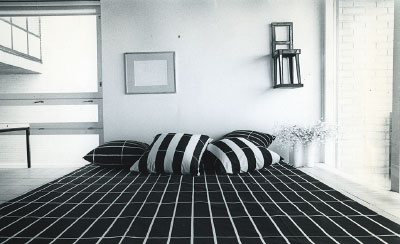文化と文化の出会い
サミ・ルオッツァライネン マリメッコ デザイナー、プロダクト開発
マリメッコ・スピリッツ―Elämäntapa(エラマンタパ)マリメッコの暮らしぶり―は日本庭園を通じて、訪れる人をフィンランドのサウナへ、更に茶室へといざないます。
マリメッコのプリント生地で装飾された茶室は、様式化された日本庭園の片隅におかれた、二つの文化が出会う色鮮やかな場です。外壁では二人の力強い女性、マリメッコの創設者であるアルミ・ラティアとデザイナー、マイヤ・イソラのチェック模様が内側で同じモチーフに関して第3の解釈と出会います。ヴォッコ・エスコリン‐ヌルメスニエミが1950年代に描いたパターン「サイコロ」の穏やかな白黒の表面は、茶道具の背景として調和した内部空間を生み出しています。外側の「煉瓦」のプリント生地には、伝統的な日本の障子を想起させる四角い模様を見ることができます。一方で、多色使いのパターン「クッコヤカナ」は、マリメッコ・グラフィックの伝統である、カラフルなパターン使いを代表しています。もとはフリーハンドで描かれたヴィヴィッドなチェック柄が、工業印刷された生地の表面に手作業の風合いを生み出しています。
フィンランド人の目から見た解釈として、カラフルな外側は、その内側に伝統的な日本の茶室のエレメンツを閉じ込めます。品揃えの選定にあたっては、アイテムを選ぶ過程で親しんできた伝統的な茶道具、そして今を遡ること15年、多治見市のセラミックパークMINOの茶室でお茶会に参加した時の思い出が大きく影響しています。こうしたことを基にして、マリメッコのアイテムの中から、茶室の内装空間を形作る品が選ばれました。道具を通じて『マリメッコ』という北欧のデザイン言語は、心の平穏、お互いの尊重、そして共に過ごすひと時に伝統的な茶事の一部となって日本文化に出会うのです。道具ひとつひとつに、長い年月の間に磨かれたその道具ならではの意味を持った役割がある、そんな何世紀も続く古い伝統、そして美学と機能性に基づいたマリメッコのデザイン哲学。両者の出会いによって興味深い対話が生まれます。
アイテムは視覚的に四季を感じさせるように考えられています。冬の後に目覚める自然、暑い夏の日差し、秋の豊かな色彩から冬の静けさまで、色やモチーフ使いによってイマジネーションを描き出しています。
「オイバ」の食器は、日常や日々の行いに対する愛情から生まれました。自宅で食卓を囲んでゆったりと一緒の時間を楽しむ、そんな毎日の静かなひと時への愛着です。アイテムひとつひとつが実用品としてデザインされており、使用目的もあまり限定されていません。アイテムの静かな佇まい、人にやさしいサイズ、そして共感をともなう感覚がアイテムの心地よさにつながっています。
カリーナ・セス-アンダーソンのフラワーベース「ウルナ」は茶道で建水の役目をしています。このことは、北欧の機能主義においてはいかにアイテムがさまざまな役割をごく自然に果たしているかを示しているでしょう。
選ばれたアイテムのパターン使いは、さまざまなデザイナーの眼を通した自然のモチーフについての解釈を表現しています。食器には、フィンランドの諸島に吹く風にそよぐ木々や岸辺の牧草、そして自然の中に表れるグラフィカルな構造が表現されています。テキスタイルには、咲き誇るたくさんの花やフィンランドの湿地風景に生えるベリーの匂い、さえずるフィンランドの鳥たちが、繊細で自然な折り目や皺とあわさって表現されています。フィンランドの自然から日本へのご挨拶を、自然の素材と自然から溢れ出る色彩の世界が伝えています。
日本庭園のもう一方の片隅にはフィンランド文化の結晶、サウナを配置しています。
フィンランド文化の一部としてのサウナの意味はとても大きく、茶室や茶道が日本文化と日本人にとって大切であることと少し似ています。サウナは家族や友人たちと共に安らげる、肉体と精神を健全に保つ源―心を落ち着かせ、体を清め、他者を尊重するための場なのです。サウナは平等な場で、サウナのベンチに座っている人は全員に同じ価値があり、同等です。フィンランド人にとってサウナは贅沢なものではなく、普段の日常の一部であり豊かな暮らしの一部です。
マリメッコは創業当初から、日々の暮らしの一部として人々の日常に美を提供してきました。マリメッコ・スピリッツ―Elämäntapa(エラマンタパ)マリメッコの暮らしぶり― では日本の茶室とフィンランドのサウナを平行して紹介し、それぞれが意味する中に一致する多くの特徴を見出す形で日本文化とフィンランド文化を並置します。マリメッコのフォルム、色彩、アイテムはどちら側ともその全体の一部として馴染みます。興味深いことに、日本の茶室とフィンランドのサウナの役割はお互いに全く違いますが、両方ともに同様な、自国の文化に深く根差した大切な意味があることに気がつくのです。
フィンランド語より翻訳:山川亜古

命名、扁額揮毫 不徹斎 千 宗守(茶道・武者小路千家 第14代家元)
茶碗等の道具はマリメッコで取り揃えられ、内外壁、仕覆、掛け軸もマリメッコのファブリックにより制作した。

アルミ・ラティア, ティイリスキヴィ, ファルク, 1952, デザインミュージアム
Cultural Interaction〜A culture meets another culture
Sami RUOTSALAINEN Senior Designer & Product Developer, Marimekko
Marimekko Spirit —Elämäntapa~Marimekko Lifestyle— guides visitors to Finnish sauna and then to Japanese tea room through a Japanese garden.
The tearoom decorated with Marimekko print fabrics is located in the corner of a stylized Japanese garden. It is a colorful space where two cultures meet. Its outer walls are covered with the fabrics designed by two vigorous women, Armi Ratia, the founder of Marimekko and Maija Isola, a designer. The checkered patterns of their fabrics meet the third interpretation inside the tearoom. Quiet surface of black and white dice pattern designed by Vuokko Eskolin-Nurmesniemi in 1950’s creates a wonderful space inside the tearoom, harmonizing the environment with tea utensils. The square brick-patterned fabric used for outside walls creates an image of traditional Japanese paper-and-wood sliding doors. On the other hand, KUKKO JA KANA, the multi-colored pattern represents the traditional colorful one of Marimekko graphics. A hand-drawn vivid checkered pattern gives a taste of manual work on the surface of mechanically printed fabrics.
Finnish interpretation is that the colorful decoration outside encloses the elements of Japanese traditional tearoom. Items are selected under the strong influence of traditional tea utensils I got familialized in the selection process and of the memory of my participating in the tea ceremony at the Ceramics Park MINO in Tajimi City. Marimekko items picked up create interior space of the tearoom. Scandinavian design language of Marimekko meets Japanese culture and the language has become a part of tea gathering through peace of mind, mutual respect and shared time. Each utensil has its role and meaning developed in the history of their use. Centuries old tradition of tea ceremony and Marimekko design philosophy based on esthetics and functionality meet and begin interesting dialogue.
Items are selected for visual sence of seasons. Nature awakening after the winter, strong sun light in the summer, beautiful color in the autumn and tranquility in the winter are depicted by colors and motifs, stimulating our imagination.
OIVA tableware was born with the love of every day life and activities. They represent attachment to a peaceful and happy time people enjoy around a kitchen table. Items are designed as utility goods without rigidly defined purposes. Items with placid appearance and feeling of empathy and of user-friendly size make people feel comfortable in using them.
URNA flower vase by Carina Seth Andersson is used as a waste-water container in the tea ceremony. You can find that items are used for multiple purposes in the Scandinavian functionalism.
The patterns on items selected for the exhibition reflect interpretation of natural motifs through the eyes of different designers. In tableware, you can see trees and pastures rustling in the wind along the Finnish island coastline as well as graphical composition found in the nature. Textiles show flowers in bloom, smell of berries in the wetland of Finland and Finnish birds in their delicate and natural folds and wrinkles. Natural materials and natural colors send greetings from the nature of Finland to Japan.
In this exhibition, there is a sauna, a crystal of Finnish culture, built opposite to the tearoom across the Japanese garden.
A sauna has a special meaning in Finnish culture as a tearoom and tea ceremony do in Japanese culture. A sauna provides Finnish people a space where they can relax with their families and friends and maintain sound body and mind. A sauna is the place to soothe their minds and purify their bodies while respecting others. People are equal in a sauna. Those who are sitting on a sauna bench are all valuable and equal as a human. To Finnish people, a sauna is not a luxuary but a part of their daily life.
Marimekko has offered people beauty in their daily life. Marimekko Spirit —Elämäntapa~Marimekko Lifestyle— introduces Japanese tearoom and Finnish sauna in parallel. The exhibition gives visitors oportunities to find many common features of the two cultures. Marimekko forms, colors and items go well with both cultures. It is interesting that Japanese tearoom and Finnish sauna play different roles but have similar important meanings deep rooted in the respective cultures.

Named and Written by Sen Futessai Sōshu Mushakōji Senke; 14th head master
The bowls and other implements are selected from Marimekko and the inner/outer walls, the pouches and the hanging scroll are made of Marimekko fabric.

Armi Ratia, Tiiliskivi, Faruk, 1952, DM